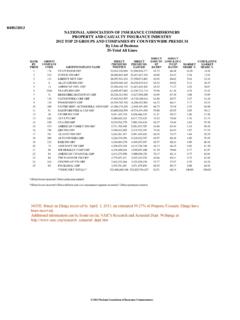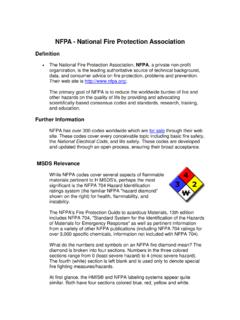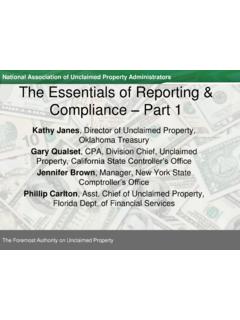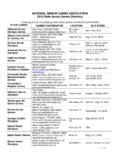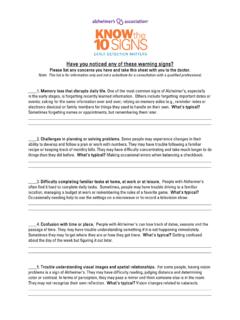Transcription of National Association for Children of Alcoholics
1 Children OF addicted parents : IMPORTANT FACTSN ational Association for Children of AlcoholicsAlcoholism and other drug addiction have geneticand environmental causes. Both have seriousconsequences for Children who live in homeswhere parents are involved. More than 28 millionAmericans are Children of Alcoholics ; nearly 11million are under the age of 18. This figure ismagnified by the countless number of others whoare affected by parents who are impaired by otherpsychoactive Alcoholism and other drug addiction tend to runin families. Children of addicted parents are moreat risk for alcoholism and other drug abuse thanare other Children . Children of addicted parents are the highest riskgroup of Children to become alcohol and drugabusers due to both genetic and family environ-ment Biological Children of alcohol dependent parentswho have been adopted continue to have anincreased risk (2-9 fold) of developing Recent studies suggest a strong genetic compo-nent, particularly for early onset of alcoholism inmales.
2 Sons of alcoholic fathers are at fourfold riskcompared with the male offspring of Use of substances by parents and their adolescentchildren is strongly correlated; generally, if parentstake drugs, sooner or later their Children will who use drugs are more likely to haveone or more parents who also use The influence of parental attitudes on a child s drugtaking behaviors may be as important as actualdrug abuse by the An adolescent whoperceives that a parent is permissive about the useof drugs is more likely to use Family interaction is defined by substance abuseor addiction in a family. Families affected by alcoholism report higher levelsof conflict than do families with no is the primary factor in family environment of Children of Alcoholics has beencharacterized by lack of parenting, poor homemanagement, and lack of family communicationskills, thereby effectively robbing Children of alco-holic parents of modeling or training on parentingskills or family The following family problems have been frequentlyassociated with families affected by alcoholism:increased family conflict; emotional or physicalviolence; decreased family cohesion; decreasedfamily organization; increased family isolation;increased family stress including work problems,illness, marital strain and financial problems.
3 Andfrequent family addicted parents often lack the ability to providestructure or discipline in family life, but simulta-neously expect their Children to be competent at awide variety of tasks earlier than do non-substance-abusing Sons of addicted fathers are the recipients of moredetrimental discipline practices from their A relationship between parental addiction andchild abuse has been documented in a largeproportion of child abuse and neglect cases. Three of four ( ) child welfare professionalscite substance abuse as the top cause for thedramatic rise in child maltreatment since Most welfare professionals ( ) report thatsubstance abuse causes or contributes to at leasthalf of all cases of child maltreatment; say itis a factor in over 75% of the cases.
4 13 In a sample of parents who significantly maltreattheir Children , alcohol abuse is specifically associ-ated with physical maltreatment, while cocaineexhibits a specific relationship to sexual Children exposed prenatally to illicit drugs are 2 to3 times more likely to be abused or neglected. 154. Children of drug addicted parents are at higherrisk for placement outside the home. Three of four child welfare professionals ( )say that Children of addicted parents are morelikely to enter foster care, and 73% say that chil-dren of Alcoholics stay longer in foster care than doother In one study, 79% of adolescent runaways andhomeless youth reported alcohol use in the home,53% reported problem drinking in the home, and54% reported drug use in the Each year, approximately 11,900 infants areabandoned at birth or are kept at hospitals, 78%of whom are drug-exposed.
5 The average daily costfor each of these babies is $ Children of addicted parents exhibit symptoms ofdepression and anxiety more than do childrenfrom non- addicted families. Children of addicted parents exhibit depressionand depressive symptoms more frequently than dochildren from non- addicted Children of addicted parents are more likely tohave anxiety disorders or to show anxiety Children of addicted parents are at high risk forelevated rates of psychiatric and psychosocialdysfunction, as well as for Children of addicted parents experience greaterphysical and mental health problems and higherhealth and welfare costs than do Children fromnon- addicted families. Inpatient admission rates and average length ofstay for Children of Alcoholics were 24% and 29%greater than for Children of non-alcoholic abuse and other mental disorders werethe most notable conditions among Children ofaddicted parents .
6 22 It is estimated that parental substance abuse andaddiction are the chief cause in at least 70-90% ofall child welfare spending. Using the more conser-vative 70 percent assessment, in 1998 substanceabuse and addiction accounted for approximately$10 billion in federal, state and local governmentspending simply to maintain child welfare The economic costs associated with Fetal AlcoholSyndrome were estimated at $ billion A sample of Children hospitalized for psychiatricdisorders demonstrated that more than 50% werechildren of addicted Children of addicted parents have a high rate ofbehavior problems. One study comparing Children of Alcoholics (aged6-17 years) with Children of psychiatrically healthymedical patients found that Children of alcoholicshad elevated rates of ADHD (Attention DeficitHyperactivity Disorder) and ODD (OppositionalDefiant Disorder) measured against the controlgroup of Research on behavioral problems demonstrated bychildren of Alcoholics has revealed some of thefollowing traits: lack of empathy for other persons;decreased social adequacy and interpersonaladaptability; low self-esteem.
7 And lack of controlover the Research has shown that Children of addictedparents demonstrate behavioral characteristics anda temperament style that predispose them to Children of addicted parents score lower on testsmeasuring school achievement and they exhibitother difficulties in school. Sons of addicted parents performed worse on alldomains measuring school achievement, using thePeabody Individual Achievement Test-Revised (PIAT-R), including general information, reading recogni-tion, reading comprehension, total reading, math-ematics and In general, Children of alcoholic parents do lesswell on academic measures. They also have higherrates of school absenteeism and are more likely toleave school, be retained, or be referred to theschool psychologist than are Children of non-alcoholic In one study, 41% of addicted parents reportedthat at least one of their Children repeated a gradein school, 19% were involved in truancy, and 30%had been suspended from Children of addicted parents compared to childrenof non- addicted parents were found at significantdisadvantage on standard scores of Maternal consumption of alcohol and other drugsduring any time of pregnancy can cause birthdefects or neurological deficits.
8 Studies have shown that exposure to cocaineduring fetal development may lead to subtle butsignificant deficits later on, especially with behav-iors that are crucial to success in the classroom,such as blocking out distractions and concentrat-ing for long Cognitive performance is less affected by alcoholexposure in infants and Children whose mothersstopped drinking in early pregnancy, despite themothers resumption of alcohol use after Prenatal alcohol effects have been detected atmoderate levels of alcohol consumption in non-alcoholic women. Even though a mother may notregularly abuse alcohol, her child may not bespared the effects of prenatal alcohol Children of addicted parents may benefit fromsupportive adult efforts to help them. Children who coped effectively with the trauma ofgrowing up in families affected by alcoholism oftenrelied on the support of a non-alcoholic parent,stepparent, grandparent, teachers and Children of addicted parents who rely on othersupportive adults have increased autonomy andindependence, stronger social skills, better ability tocope with difficult emotional experiences, andbetter day-to-day coping Group programs reduce feelings of isolation,shame and guilt among Children of Alcoholics whilecapitalizing on the importance to adolescents ofpeer influence and mutual Competencies such as the ability to establish andmaintain intimate relationships, express feelings.
9 And solve problems can be improved by buildingthe self-esteem and self-efficacy of Children Kumpfer, (1999). Outcome measures of interventions in the study ofchildren of substance-abusing parents . Pediatrics. Supplement. 103 (5) Schuckit, , Goodwin, , & Winokur, G. (1972). A study ofalcoholism in half siblings. American Journal of Psychiatry, 128: Goodwin, (1985). Alcoholism and genetics. Archives of GeneralPsychiatry, 42, Fawzy, , Coombs, , & Gerber, B. (1983). Generational continuityin the use of substances: the impact of parental substance use on adolescentsubstance use. Addictive Behaviors, 8, Skiffington, & Brown, (1981). Personal, home, and schoolfactors related to eleventh graders drug attitudes.
10 International Journal ofthe Addictions, 16(5), Barnes, , & Windle, M. (1987). Family factors in adolescent alcoholand drug abuse. Pediatrician, 14, McDermott, D. (1984).The relationship of parental drug use and parents attitude concerning adolescent drug use to adolescent drug use. Adolescence,XIX(73), Moos, & Billings, (1982). Children of Alcoholics during therecovery process: alcoholic and matched control families. AddictiveBehaviors, 7 el Guebaly, N. & Offord, (1997). The offspring of Alcoholics : acritical review. American Journal of :4, Kumpfer, & DeMarsh, J. (1986). Family environmental and geneticinfluences on Children s future chemical dependency.
